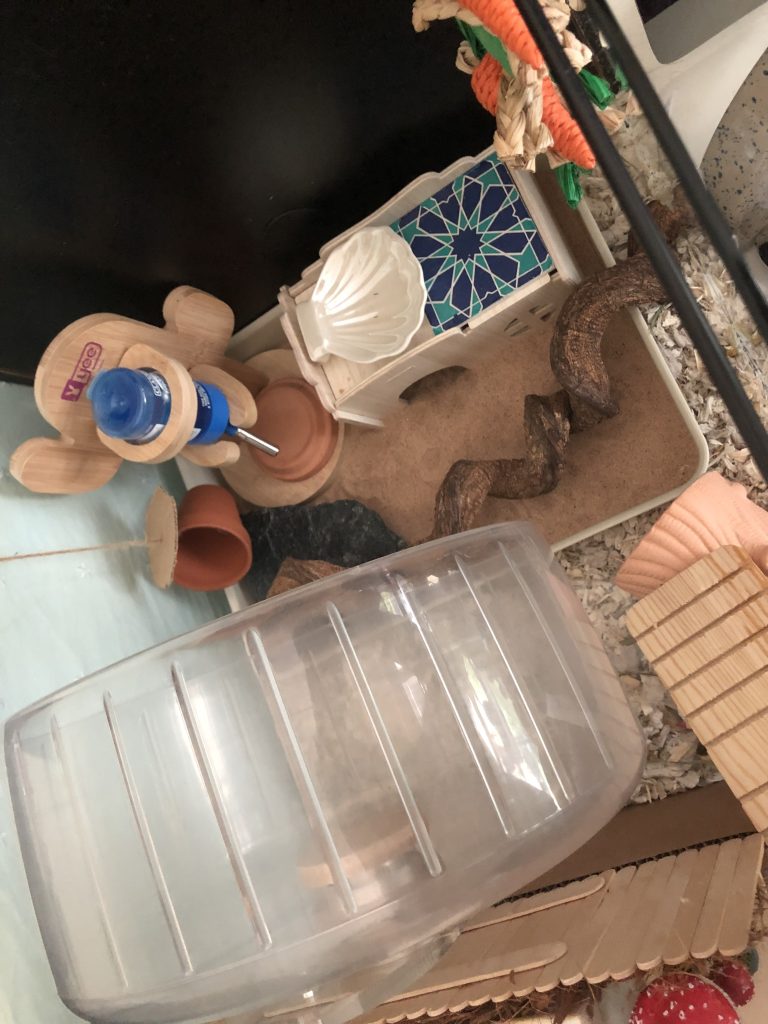Hamsters are a popular choice for many people looking for a pet. They’re small, adorable, and don’t need walks, making them seem like the perfect low-maintenance companion. Unfortunately, these little critters often don’t get the care they truly need and are sometimes kept in unsuitable conditions, which can affect their health and welfare. In this article, we’ll cover several important topics to help you learn how to properly care for your hamster and ensure your tiny friend lives a happy, healthy life.
About the hamster
Hamsters are crepuscular and nocturnal, meaning they’re most active around sunset, sunrise, and at night. Because of this, they can be sensitive to the time of day you handle them, so it’s best to interact with them during their natural waking hours. They may wake up briefly during the day to go to the bathroom, have a snack, or take a sip of water, but their natural instinct is to return to their nest soon after for more rest.
Hamsters have relatively short lifespans, averaging around 2 to 3 years with proper care. Almost all hamster breeds are solitary by nature and prefer to live alone, though a few specific breeds can be housed in pairs or small groups. It’s important to research the breed you’re planning to get, keeping solitary hamsters together can cause stress and lead to serious fights that may result in injury or even death.
Because hamsters are small, delicate creatures, they may not be the best choice for very young children who might find it hard to handle them gently. However, for older children who understand how to be calm and careful, hamsters can make great pets that are a joy to watch and care for.
Cage
The first thing to be aware of is that most hamster cages sold in pet stores are far too small for a hamster’s needs. A larger space is always better, as hamsters love to dig, run, and explore. More suitable options include spacious reptile tanks, terrariums, or aquariums. Depending on which you choose, you’ll need to make some adjustments to ensure the enclosure is safe, well-ventilated, and comfortable.
Many hamster owners also get creative by turning IKEA shelving units or storage boxes into custom enclosures. If you decide to build your own, make sure the setup has plenty of airflow and enough space for deep bedding, a wheel, and enrichment toys.

Depending on the type of hamster, the recommended minimum floor space for their enclosure can vary, so it’s important to research the specific needs of your chosen breed. Place the cage in a quiet, stable spot, away from loud noises, direct sunlight, and drafts. Use only natural materials for the bedding, and make sure to provide a thick layer of at least 30 cm. Pressing the bedding down slightly helps your hamster create sturdy burrows, allowing them to express their natural digging instincts.
Most commercial wood shavings sold in pet stores are unsuitable for hamsters, as they’re often too dusty, leading to respiratory issues, or are made from pine or cedar, which can be toxic and cause long-term health problems. Avoid cat litter, scented bedding, and any unlabeled materials, as well as fluffy bedding marketed for hamsters, which can be dangerous if ingested or if your hamster becomes tangled in it. Safe bedding options include timothy or orchard hay, aspen wood shavings, or paper-based bedding.
Provide your hamster with a sand bath filled with dust-free, microorganism-free sand, such as chinchilla sand or children’s play sand. You should also create a toilet area, as hamsters are naturally clean animals and tend to use the same spot for their toilet needs. With some patience, you can even litter train your hamster. Finally, make the enclosure fun and stimulating by adding tunnels, chew toys, and other forms of enrichment to encourage your hamster’s natural behaviours and keep them happy and active.
Exercise and enrichment
Make sure your hamster’s enclosure offers plenty of opportunities for exercise and exploration. A suitable hamster wheel is essential, but it’s important to choose the correct size, your hamster’s back should remain straight, not curved or bent, when running.
In addition to a wheel, provide lots of enrichment to keep your hamster active and mentally stimulated. Burrowing is one of their most natural behaviours, so make sure there’s enough deep, suitable bedding for them to dig and tunnel in. You can also add a digging box filled with a safe substrate, such as beech chips, to give them more variety.
Include small houses for hiding, chew toys for gnawing, and other toys to climb on and explore. There are many creative do-it-yourself ideas online for making enrichment items, so you can easily add fun and variety to your hamster’s home while catering to their natural instincts.

Your hamster also needs regular time outside the cage to explore and stay active. A great and safe way to do this is by setting up a secure, gated play area where they can roam freely. In this space, you can add plenty of toys, tunnels, and hide treats to encourage natural foraging and exploration while allowing them to interact with their human family.
Always supervise your hamster closely when they’re outside their enclosure, as they are quick, curious, and can easily slip into small spaces or chew on unsafe objects.
Feeding
Hamsters are omnivores, meaning they need a varied and balanced diet to stay healthy. Watery fruits and vegetables should only be offered in small amounts, as too much can upset their digestive system.
Provide a daily bowl of high-quality hamster mix and lab blocks. Ideally, their diet should contain around 16% protein and 5% fat, so check the label when choosing a brand. In addition, offer small portions of fresh, safe vegetables, fruits, flowers, herbs, and protein sources. Vegetables, especially leafy greens, should be given more often than fruit. Remember that hamsters love to hoard food, so regularly check for hidden pieces that may spoil or rot.
Suitable vegetables and fruits include kale, cucumber, peas, carrots, apples (no seeds), banana, celery, broccoli, cauliflower, dandelion leaves, and beansprouts. For extra protein, you can give small portions of cooked chicken or turkey, mealworms, crickets, boiled eggs, or even a bit of dry cat food.
Avoid giving your hamster foods such as chocolate, salty or spicy foods, onions, garlic, peanut butter, sandwich meats, almonds, canned food, junk food, pork, raw potatoes, kidney beans, eggplant, fool’s parsley, avocado, raw rhubarb, tomato leaves, fruit pits or seeds, citrus fruits, watermelon, jam, leeks, scallions, chives, pickles, and buttercups.
These are not complete lists, and if you’re unsure whether something is safe for your hamster, always double-check before feeding it.
Cleaning
Daily care includes cleaning your hamster’s water and food bowls and refilling them with fresh water and food. The toilet area should also be cleaned every day to keep the enclosure hygienic. Spot clean the bedding regularly and replace any soiled or wet areas as needed.
Once a week, give the entire cage a thorough clean, including all toys, tunnels, and accessories. Make sure to use a non-toxic, pet-safe cleaner, and allow everything to dry completely before setting it back up for your hamster.
Handling
When handling your hamster, gently cradle them in your cupped hands and keep them close to a surface in case they wriggle or jump. Always handle them calmly and confidently, taking extra care to ensure they don’t slip through your hands.
Care
Hamsters are naturally very clean animals and groom themselves regularly, so they don’t need to be brushed or bathed. In fact, bathing your hamster can be extremely dangerous and may even be fatal, as getting them wet can cause stress or illness. Your hamster will take care of its own hygiene, all you need to do is provide a sand bath to help keep its coat clean and healthy.

Keep a close eye on your hamster’s health by monitoring their appetite, behaviour, and stool. A loss of appetite or abnormal droppings should always be checked by a vet. Regularly examine your hamster’s body for wounds or sores (including under the feet), and watch for any changes in breathing, movement, or the condition of their fur.
Hamsters’ teeth grow continuously throughout their lives and normally wear down through eating and chewing. However, sometimes this doesn’t happen as it should, so it’s important to regularly check the length of their teeth and ensure they always have plenty of chew toys available. Their nails can also grow quickly, if they don’t wear down naturally on cage accessories, they may need to be clipped by you or a vet.
Because hamsters are tiny and fragile, health problems can progress very quickly. If you notice anything unusual, it’s best to take your hamster to the vet sooner rather than later.
Conclusion
Hamster care is often underestimated. Their needs for proper housing, diet, and enrichment are more complex than many people realise. By sharing information and raising awareness, we hope to improve the welfare of hamsters kept as pets and help future owners make a well-informed decision about whether a hamster is the right pet for them.
Did you know we also pet sit hamsters? Our critter sitters are knowledgeable about hamster care and will love your little hamster like it’s their own. Feel free to contact us for more information about our pet sitting service.

